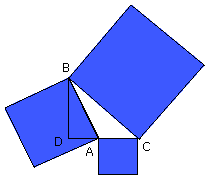In obtuse-angled triangles the square on the side subtending the obtuse angle is greater than the squares on the sides containing the obtuse angle by twice the rectangle contained by one of the sides about the obtuse angle, namely that on which the perpendicular falls, and the straight line cut off outside by the perpendicular towards the obtuse angle.
 Let ABC be an obtuse-angled triangle having the angle BAC obtuse, and let BD
be drawn from the point B perpendicular to CA produced;
Let ABC be an obtuse-angled triangle having the angle BAC obtuse, and let BD
be drawn from the point B perpendicular to CA produced;
 I say that the square on BC is greater than the squares on BA, AC
I say that the square on BC is greater than the squares on BA, AC
 by twice the rectangle contained by CA, AD.
by twice the rectangle contained by CA, AD.
 For, since the straight line CD has been cut at random at the point A,
For, since the straight line CD has been cut at random at the point A,
 the square on DC
the square on DC
 is equal to the squares on CA, AD and twice the rectangle contained by CA, AD.
is equal to the squares on CA, AD and twice the rectangle contained by CA, AD.
 Let the square on DB be added to each; therefore the squares on CD, DB
Let the square on DB be added to each; therefore the squares on CD, DB
 are equal to the squares on CA, AD, DB and twice the rectangle CA, AD.
are equal to the squares on CA, AD, DB and twice the rectangle CA, AD.
 But the square on CB is equal to the squares on CD, DB, for the angle at D is
right;
But the square on CB is equal to the squares on CD, DB, for the angle at D is
right;
 and the square on AB is equal to the squares on AD, DB;
and the square on AB is equal to the squares on AD, DB;
 so that the square on CB is greater than the squares on CA, AB by twice the
rectangle contained by CA, AD.
so that the square on CB is greater than the squares on CA, AB by twice the
rectangle contained by CA, AD.
Therefore etc.
Q.E.D